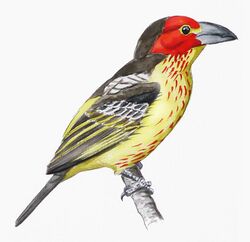Biology:Vieillot's barbet
| Vieillot's barbet | |
|---|---|

| |
| Scientific classification | |
| Domain: | Eukaryota |
| Kingdom: | Animalia |
| Phylum: | Chordata |
| Class: | Aves |
| Order: | Piciformes |
| Family: | Lybiidae |
| Genus: | Lybius |
| Species: | L. vieilloti
|
| Binomial name | |
| Lybius vieilloti (Leach, 1815)
| |
| Subspecies[2] | |
| |
Vieillot's barbet (Lybius vieilloti) is a small bird in the family Lybiidae. Barbets and toucans are a group of near passerine birds with a world-wide tropical distribution. The barbets get their name from the bristles which fringe their heavy bills. This bird is named after the French ornithologist Louis Pierre Vieillot.[3]
Habitat
The Vieillot's barbet is a resident breeder in the African scrubland on the southern edge of the Sahara Desert from Senegal to Ethiopia. It is often found along wooded creeks in Zaria, Nigeria and its breeding season takes place during the months of April to July.[4] It is an arboreal species of savannah and farmland which eats insects and fruit, especially figs. It nests in a tree hole, laying three eggs.
Description
This is a sparrow-sized barbet at 15 cm (5.9 in). It is a plump bird, with a short neck, large head and short tail. The adult has a red head, and the neck and breast are a mixture of red and white. The upperparts are dark brown apart from a yellow stripe down the back. The rest of the underparts are yellowish with dark flank spotting. The bill is thick and dark grey. Sexes are similar, but immature birds are duller.
Calls
This species of African barbet is known to duet year-round, unlike other species that only duet during breeding season. The L. vieilloti has been reported to "yodel", which is a succession of two flute-like notes which are uttered by two birds sitting on a bough as they bow ceremoniously to each other. This yodel is immediately answered by the other bird of the pair with the sound "poop-poop". The duet seems to be initiated by a snarl like the Lybius torquatus. The duets are considered quite unusual because the birds call with different rhythms. Other duetting pairs have occasionally accompanied or followed the original duetting pair.[4] This species uses simultaneous polyphonic duets with a pre-duet greeting ceremony. Polyphonic duets have many sounds occurring simultaneously so the song sounds "many-voiced".[5]
References
- ↑ BirdLife International (2016). "Lybius vieilloti". IUCN Red List of Threatened Species 2016: e.T22681816A92921762. doi:10.2305/IUCN.UK.2016-3.RLTS.T22681816A92921762.en. https://www.iucnredlist.org/species/22681816/92921762. Retrieved 12 November 2021.
- ↑ Gill F, D Donsker & P Rasmussen (Eds). 2020. IOC World Bird List (v10.2). doi : 10.14344/IOC.ML.10.2.
- ↑ Beolens, Bo; Watkins, Michael (2003). Whose Bird? Men and Women Commemorated in the Common Names of Birds. London: Christopher Helm. p. 352.
- ↑ 4.0 4.1 Payne, R. B., and N. J. Skinner. "Temporal Patterns of Duetting in African Barbets." Ibis 112.2 (1970): 173-183. Web.
- ↑ Short, Lester L., and Jennifer F. Horne. "A Review of Duetting, Sociality and Speciation In Some African Barbets (Capitonidae)." Condor 85.3 (1983): 323-32. Web.
- Birds of The Gambia by Barlow, Wacher and Disley, ISBN:1-873403-32-1
Wikidata ☰ Q886506 entry
 |



